BLUE
DASHER
Pachydiplax
longipennis
|
|
Blue Dasher is an attractive, active,
pond-loving dragonfly. Males perch above the pond, actively dashing out
after prey or to defend their territory, and then return to their
favored perch.
|
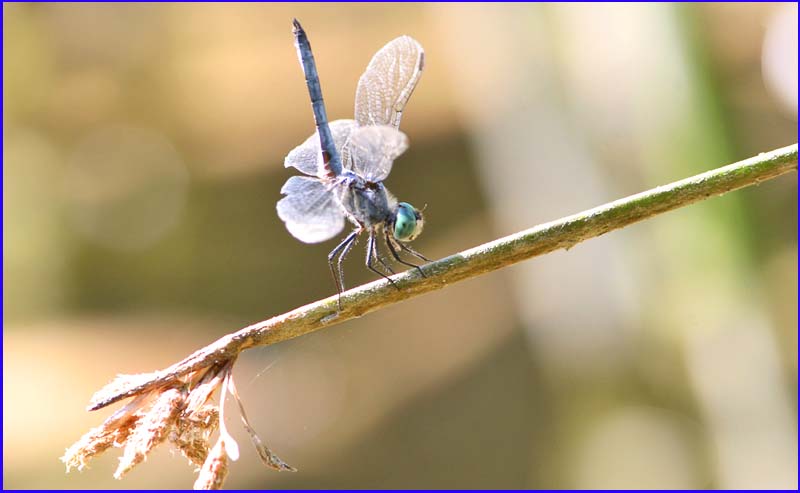
Blue Dasher typically perches either with its
wings hunched forward (photo at top of page) or wing wings swept back
(just above), and readily takes the "obelisk" position (as above) on
hot days to thermoregulate. All these positions give it a certain
charismatic appearance, like a jet fighter ready to launch.
Blue Dasher often frequents the same ponds as
Western Pondhawk, and the mostly blue males are similar. Blue Dasher,
though, has a white face and green eyes – rather than a green face and
dark blue eyes – and does not perch on the ground like the pondhawk.
|
|
Photo (very top
& below) 1 July 2006 Hastings NHR
Photo (just above) 24 July 2006 Arroyo Seco
|
|
|
|
|
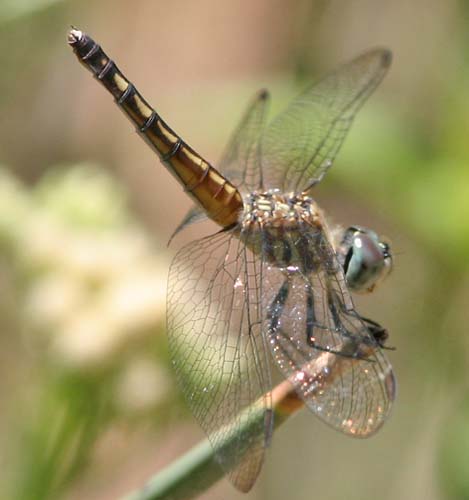 |
Female Blue Dasher (above & left) can
take on the charismatic poses, but she is patterned in yellow with
black (racing) stripes, both on the thorax and abdomen. Her eyes are
green but suffused with brown, but she has a white face like the male.
Photo (above) 24 July 2006
Arroyo Seco
Photo (left) 5 Aug 2006 Arroyo Seco
|
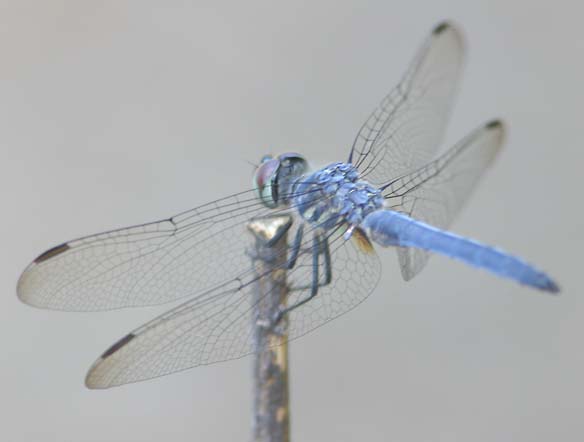 Immature males start out like
females but rapidly gain the blue pruinescence over the abdomen and
front of the thorax. It is the sides of the thorax that are last to
color in, producing a blue male with dark-and-pale yellow racing
stripes on its thoracic sides. In this individual (right), the eyes
have also not gained their rich green color. Immature males start out like
females but rapidly gain the blue pruinescence over the abdomen and
front of the thorax. It is the sides of the thorax that are last to
color in, producing a blue male with dark-and-pale yellow racing
stripes on its thoracic sides. In this individual (right), the eyes
have also not gained their rich green color.
In eastern populations, even full adult
males retain the stripes on the sides of the thorax (Beaton 2007). Here
in the West, some males become all-blue but others do not. Eye color
may be a better character to judge full maturity.
|
|
| From underneath (below), such young males often
may show many characters of immaturity, including a black-and-yellow
abdomen and rusty coloration at the rear of the thorax, or at the base
of the abdomen. However, even full adult males can show that latter
feature. |
|
Photo (above) 24
July 2006 Arroyo Seco
Photo (below) 20 June 2006 near Chico, Butte Co.
|
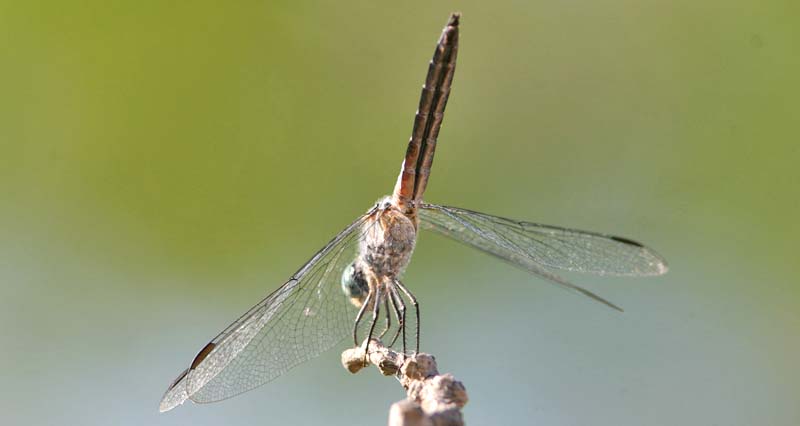
|
|
The size of Blue Dashers can change dramatically
over the summer. Early emergers (like the young male just above) are
quite large compared to those that emerge later in the season.
Since the first Blue Dasher was collected in MTY
in 1963, the Arroyo Seco Lakes – next to the Arroyo Seco Campground –
have been the center of local occurrence, with many observations from
that locale (and many photos shown on this page). Upon to 30
individuals have been seen on dates in July and early August. However,
the species is likely widespread in appropriate habitat throughout the
county.
|
|
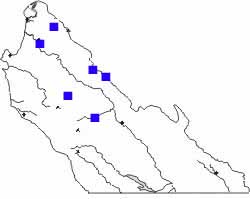 The map shows a selection of sites at which
Blue Dasher has been observed. It may be widespread throughout the
county in the lowlands, although as yet no records are right near the
coast. It is possible that the species doesn't like the summer fog so
typical of our coast. The map shows a selection of sites at which
Blue Dasher has been observed. It may be widespread throughout the
county in the lowlands, although as yet no records are right near the
coast. It is possible that the species doesn't like the summer fog so
typical of our coast.
In MTY flight dates stretch from 20 May to
10 Aug. Elsewhere in California flight dates span nearly all months,
from Feb–Nov (Manolis 2003), so its flight span in MTY is likely longer
than currently reported.
|
|
Literature cited:
- Beaton, G. 2007. Dragonflies and Damselflies of
Georgia and the Southeast. Univ. Georgia Press, Athens GA.
- Manolis, T. 2003. Dragonflies and Damselflies of
California. Univ. of Calif. Press, Berkeley.
Web resources:
Major identification web sites with much information on California
odes include:
For sites with excellent photos to compare for identification or to
simply
enjoy, see:
Many of these sites have links to other useful pages. Kathy Biggs's
site
is particularly useful in her selection of links. |
